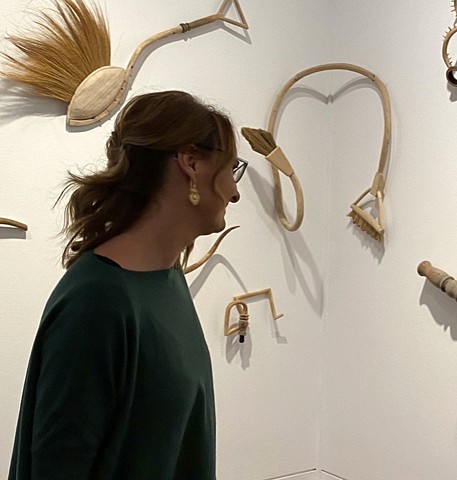Biography

Instagram: instagram.com/katestehr/
Facebook: facebook.com/katestehrartist
Sales/Communication: katestehr@live.com
Kate Stehr is a trained sculptor with a Masters of Philosophy in Creative Arts Research, an Advanced Diploma of Fine Arts, and Bachelor of Fine Arts (Honours). Her two key artistic pursuits are sculpture and collage, with each practice different and yet informing the other. Kate also works as a mural artist, working with students in schools to create spray-painted murals. You can see her work at:
https://www.instagram.com/kate_stehr_murals
She is a passionate gardener, cider drinker, motorbike rider and lover of giant dogs! Kate is also member of the Illawarra Association for the Visual Arts (IAVA).
Her works range through a number of conceptual drives, including ladders and architecturally inspired works, scribing tools, mythology and most recently an interest in Zoo and Phytoplankton as a metaphor for environmental concerns.
In her ladder and architectural works, Kate enjoys creating absurdist structures. These playful works invite the viewer to explore. The use of ladders and stairs, encourage the eye to move through and over the forms. Made predominantly from reclaimed timbers, these works reference the surrealist landscapes of Escher.
In the recent Scribing Tools series (I, II and III), she continues to explore her interest in telling stories. She has had a long interest in creating works that explore the traditional narratives that are the foundation of our cultures, as evidenced in the research and creative works for her Masters of Philosophy Degree.
Prior to these pieces she engaged in creating sculptural ‘runes’. These small timber works sought to distil personal narratives and remembrances into simplified sculptural forms. This led to her creating the aforementioned series of scribing instruments. She saw these works as being the tools from which her runes were drawn.
She has argued in previous work series that traditional narratives need to be retold and reinterpreted for contemporary audiences. These scribing tools belong as part of these artistic explorations, providing a link between story and written word. Using transmedial narratology as a framework, she explores how narratives can be conveyed as sculptural forms. Transmedial narratology contends that narrative can be conveyed through all the creative mediums, not just oral and written forms.
Predominantly hand carved from timber in a naïve style, these works also feature found objects. Resembling giant, often disjointed brushes and styluses, the works encourage the audience to visualise them in use, in scrawling imagined gestures. What marks might they splash across the chosen surface, if picked up and dipped in ink? The abstraction of form and the desire to play with a sculptural ‘line’ can also be found in the linear wall pieces.